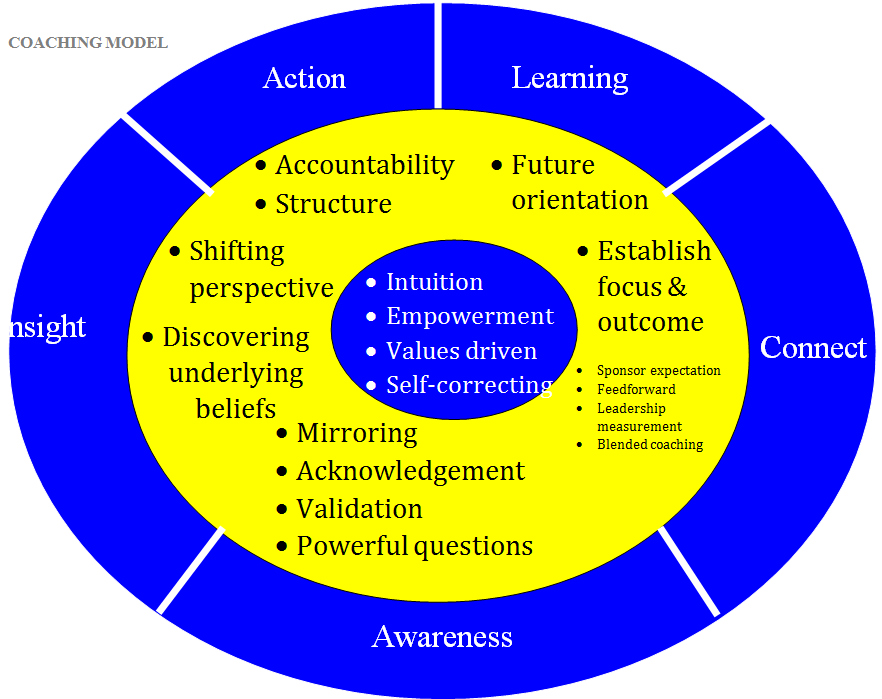A Coaching Model Created by Gerald Ebenezer
(Executive Coach, MALAYSIA)
There are three models that have influenced the development of my coaching model. Each of them is discussed below.
a) TGOROW model
Developed by Christian Simpson, a John Maxwell Team Faculty member.
I feel that this model expands the GROW model framework to include the Topic at the beginning of the conversation before diving into the Goal aspect. Once the Goal has been established, the model also establishes the Outcome the client seeks from the session as this may be one aspect of the Goal that the client wants to focus on for this particular session. It allows focus and clarity as to what the clients seeks to achieve by end of the session. It then follows logically to the Reality, Options and Way Forward aspects. In my mind, this model assumes a linear approach that at times may impose a forced structure and flow on the coaching conversation that may restrict the coach’s ability to be sensitive to the client’s needs at any point in time.
b) Keith Webb’s coaching model.
It begins with “Connecting” with the client and following-up on previous action steps (What progress have you made on your action steps?). This is particularly useful as building trust and rapport is critical to the coaching conversation.
The next step is “Outcome” that parallels the TGOROW model by Christian Simpson.
The next step is “Awareness” which is the breakthrough the client is looking for in terms of either moving from a disempowering perspective to an empowering perspective or uncovering limiting beliefs that are not helping or any other discoveries the client may make.
The next logical step is “Course” that is the action steps the client could and is willing to do.
The final process is “Highlights” is essentially- What new awareness do you have now that you did not have before? This is basically the Learning component of the process that the client could record and reflect on for the future. This model appears more flexible as it allows iteration between the all the different stages in a coaching conversation. (http://keithwebb.com/coach-model/)
c) Marshall Goldsmith Stakeholder Centered Coaching
Marshall’s highly successful approach to executive development and coaching includes a strong emphasis on involvement of stakeholders, implementation of change and follow-through to measure growth in leadership effectiveness. In the end the only thing that counts is leadership growth i.e. leadership (behavior) effectiveness on the job as perceived by stakeholders. As Marshall puts it:
Leadership Change and Coaching are simple but not easy!
Stakeholder Centered Coaching developed by Marshall Goldsmith appears to be a highly effective, transparent, structured and time efficient process that works as follows:
Determine 1-2 Leadership Growth Areas Important to the Leader and the Organization
B1. Involve Stakeholders to Capture Feedforward Suggestions
B2. Stakeholder-Based Monthly Action Planning
B3. Change behavior and perception through execution on the job
Perception is Reality: Measure Leadership Growth based on Stakeholders’ Perception
Marshall’s approach ties in nicely to the executive and leadership coaching niche that I want to focus on as it has a clear and strong link to stake holder perceptions which in turn impacts how a leader is viewed within an organization. This view is a key consideration in career development decisions and works to the vested interest of the leader within the existing organizational context.
My coaching model
Based on what I have gathered from the market, organizations have a strong preference for some aspect of training and mentoring to accelerate the professional development of their leaders. As such, executive coaches who offer a blended approach in their professional coaching toolkit appear to have a marketing advantage. Hence I seek to adopt a “Blended Coaching” approach as part of my toolkit where the traditional core of pure professional coaching is maintained whilst remaining flexible to step outside the coaching conversation into the realm of “consultant/trainer” when its is clear that the client could benefit from another perspective subject to coach/client acknowledgement of inherent contextual factors.
The key components of my blended coaching model can best be encapsulated in a bulls-eye format with three concentric circles consistent with the Golden Circle format codified by Simon Sinek in his famous Ted talk in 2009 – The Why, How and What.
Essentially the inner concentric bulls-eye speaks to the “WHY” – the outcomes for both the client and the coach throughout the sessions and post coaching future in the form of “Intuition, Self-correcting, Empowered, and Values-driven”.
The middle concentric circle is the HOW – describes the tools the coach deploys in the coaching conversation throughout the coaching process – Presence, Listening Intently, Powerful Questions, Mirroring, Acknowledgement, Validation, Accountability, Establishing Structure and Power Tools.
The outermost concentric circle talks about the WHAT- characterized by the coaching process flow of “Connect, Awareness, Insight, Action and Learning”. This process is iterative and the coach remains flexible within the process to best serve the needs of the client.
| The WHAT | Objectives | The HOW |
| Connecting | Building Rapport
Establish focus and outcomes |
*Sponsor expectations
Powerful Questions Mirroring Visualization Acknowledgement Power Tools Validation *Feed forward Establishing structure, accountability *Leadership measurement Blended coaching |
| Awareness | Making the unconscious conscious – exploring meaning, alignment with values | |
| Insight | Discovering underlying beliefs
Shifting perspectives |
|
| Action | Exploring options and next steps | |
| Learning | Explore takeaways for future |
* – Stakeholder Centered inputs for leadership/executive coaching
The blended aspect is allowed to emerge as the situation dictatesto help the client get unstuck or consider options that may be out of his/her current awareness by stepping away from the coaching conversation (and hence out of the bulls-eye) into a consultative/training mode albeit for a brief moment. This would be initiated only upon obtaining permission from the client
